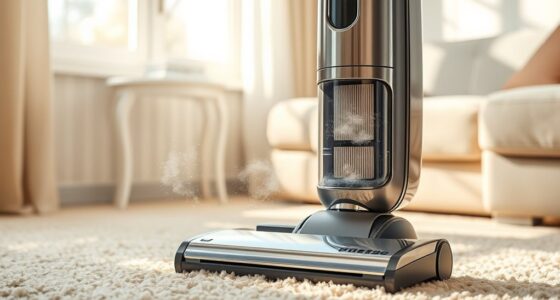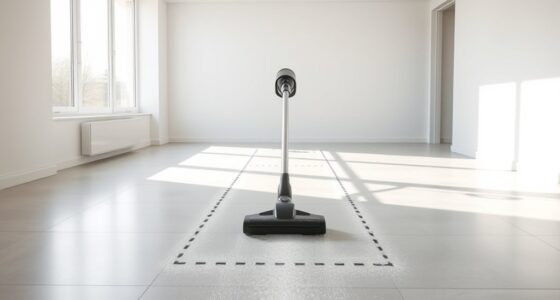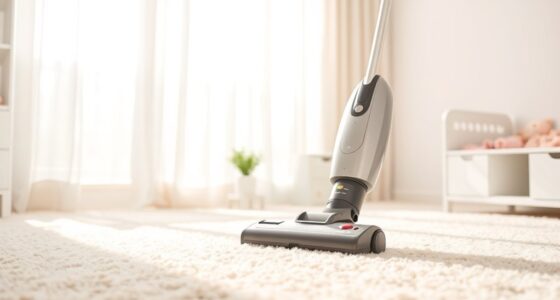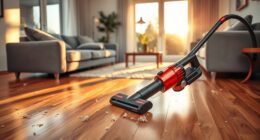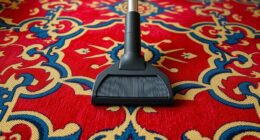To manage dust and allergens in homes with open windows year-round, select a vacuum with strong suction and HEPA filters, and perform regular maintenance. Vacuum at least twice a week, focusing on high-traffic areas, edges, and hidden spots. Use attachments like crevice tools and dusting brushes, and incorporate air purifiers for better air quality. Keep window screens clean and sealed to reduce outdoor debris, and you’ll discover more tips to keep your home fresh.
Key Takeaways
- Use vacuum cleaners with HEPA filters and strong suction to trap outdoor dust and allergens effectively.
- Increase vacuuming frequency near open windows, focusing on entryways, floors, and hidden areas to reduce indoor dust buildup.
- Employ zone-specific attachments and techniques for thorough cleaning of hard-to-reach spots and outdoor-influenced surfaces.
- Combine regular vacuuming with air purifiers to improve indoor air quality and minimize outdoor particulate intrusion.
- Maintain vacuum equipment and clean window screens frequently to prevent debris buildup and enhance airflow.
Choosing the Right Vacuum Cleaner for Open-Window Homes
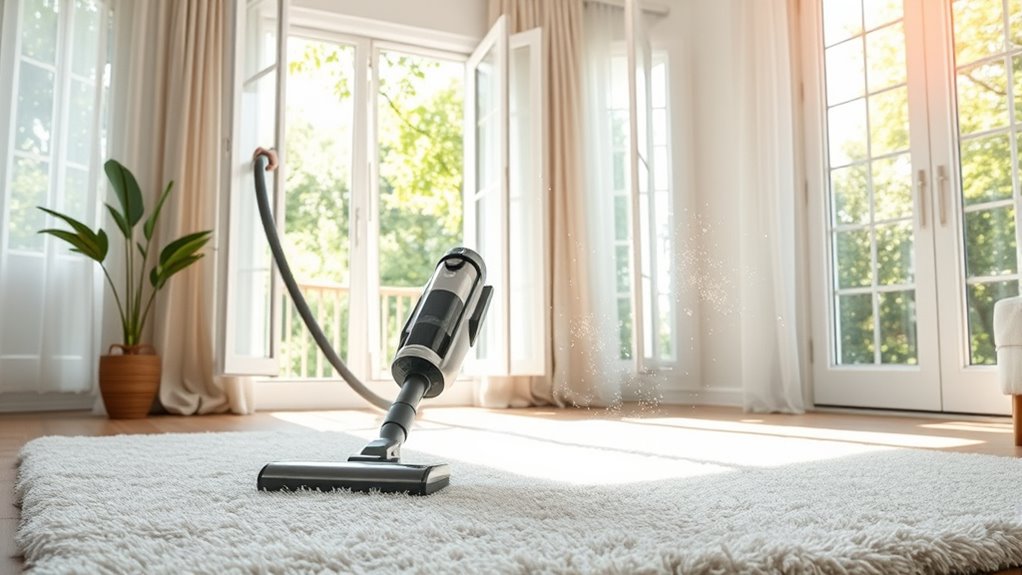
When you have open-window homes, selecting the right vacuum cleaner becomes especially important to handle the unique challenges of outdoor air and debris. Your vacuuming techniques need to adapt to maintain ideal home air circulation and prevent outdoor dust from settling inside. Look for models with strong suction and excellent filtration, such as HEPA filters, to trap allergens and particles brought in by open windows. Lightweight and versatile vacuums make it easier to navigate around open doorways and outdoor debris. Consider a machine with adjustable settings for different surfaces, ensuring you can effectively clean both indoor flooring and outdoor entry mats. Choosing the right vacuum helps you manage outdoor influences, keeping indoor air cleaner and your home fresher. Additionally, understanding the benefits of air filtration can help you select equipment that improves indoor air quality even further.
Establishing a Regular Vacuuming Schedule
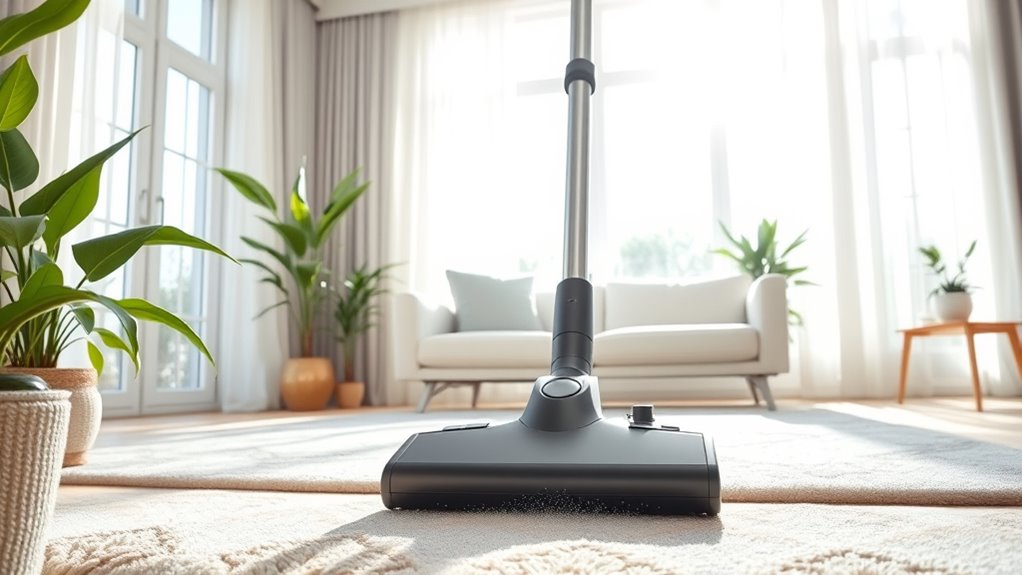
Establishing a regular vacuuming schedule is essential for maintaining a clean and healthy home environment. Consistency helps control dust buildup and prevents allergens from circulating. Depending on your home’s foot traffic and open windows, your vacuuming frequency may vary, but aim for at least twice a week. To optimize dust prevention, consider different areas’ needs:
| Area | Recommended Vacuuming Frequency |
|---|---|
| Living room | 2-3 times per week |
| Bedrooms | 1-2 times per week |
| Entryways | Every other day |
| Kitchen | 2 times per week |
| Windows near open areas | 3 times per week |
Adjust your schedule based on dust levels and seasonal changes to keep your space fresh and allergen-free. Regular vacuuming helps reduce the accumulation of necessary cookies and other particles that can impact indoor air quality.
Techniques for Effective Dust and Debris Removal
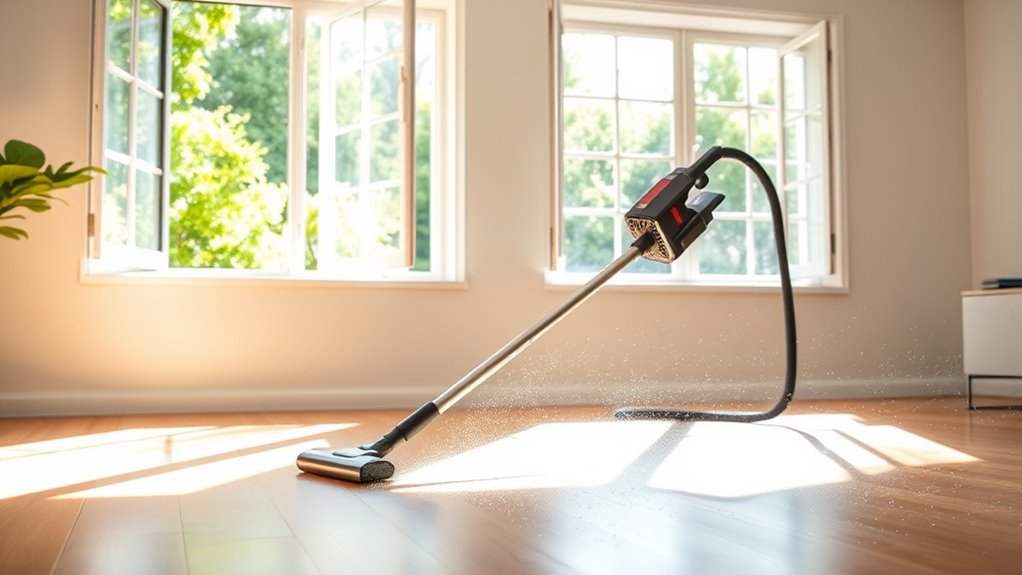
To remove dust and debris effectively, focus on using proper techniques that maximize cleaning efficiency. Start by changing your vacuum attachments based on the surface you’re cleaning—use a brush nozzle for carpets and a crevice tool for edges. Incorporate DIY vacuum hacks, like wrapping socks around vacuum nozzles to trap finer dust particles or attaching microfiber cloths for extra dust pickup. Always vacuum slowly to allow the machine to pick up more debris and avoid missing spots. For eco-friendly cleaning, opt for vacuums with adjustable suction levels to reduce energy use and minimize waste. Regularly clean filters and bags to maintain peak performance. Studies indicate that using the correct vacuum attachments can significantly improve dust removal efficacy. These methods help ensure thorough dust removal while supporting sustainable cleaning habits in your home.
Using HEPA Filters to Improve Indoor Air Quality
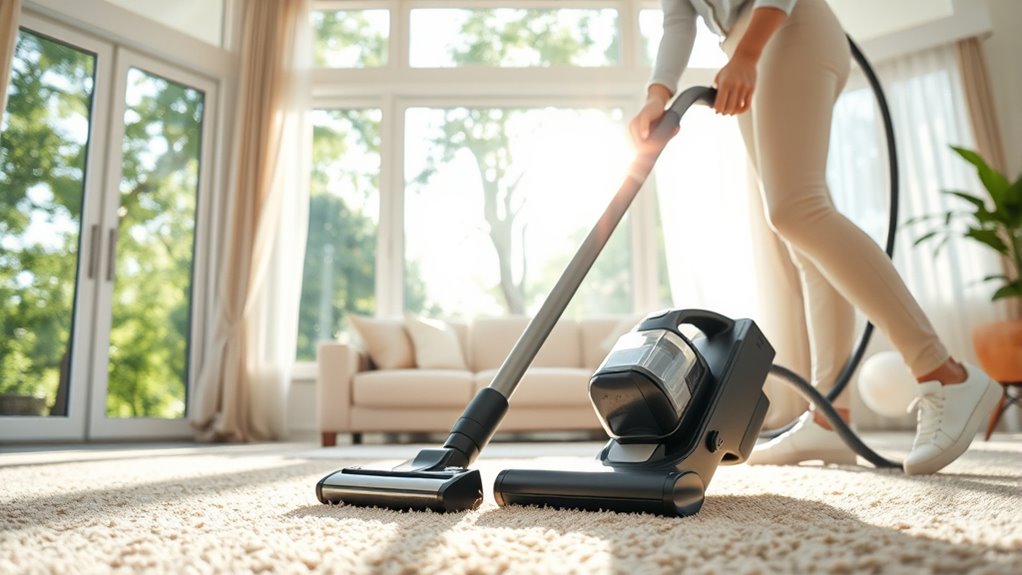
HEPA filters are highly effective at capturing tiny particles, including allergens and dust mites, which can notably improve your indoor air quality. To keep them working efficiently, you need to perform regular filter maintenance and replace them as recommended. By using HEPA filters properly, you’ll notice a clearer, healthier environment in your home. Implementing data analytics can further optimize your filter replacement schedule and maintenance routines.
HEPA Filter Effectiveness
You are trained on data up to October 2023.
Proper Filter Maintenance
Ever wondered how proper filter maintenance can maximize the benefits of HEPA filters? Regularly replacing your filter ensures best air quality and extends its lifespan. Neglecting filter replacement can lead to reduced efficiency and increased indoor pollutants. To keep your HEPA filter in top shape, follow these key tips:
- Check the manufacturer’s recommended filter lifespan
- Replace filters promptly when they become dirty or clogged
- Avoid using filters beyond their specified lifespan
- Keep the filter housing clean to prevent debris buildup
- Record replacement dates to stay on schedule
- Staying informed about AI’s impact on privacy and regulation can help you better understand the importance of maintaining safe indoor environments.
Maintaining your filters properly not only improves air quality but also prolongs their effectiveness, saving you money in the long run. Consistent filter replacement is essential for maximum performance in homes with open windows year-round.
Air Quality Benefits
Using HEPA filters can considerably enhance your indoor air quality by capturing tiny airborne particles that standard filters often miss. This improvement boosts indoor air circulation by reducing dust, pollen, pet dander, and other allergens, making your environment healthier. Since open windows can allow outdoor pollutant infiltration, HEPA filters help mitigate these pollutants’ impact inside your home. By trapping harmful particles before they circulate, they lower respiratory irritants and allergy triggers. This creates a cleaner, fresher atmosphere, especially beneficial if you’re sensitive to airborne contaminants. Regularly using HEPA filters ensures that even with windows open, your indoor air remains healthier and less polluted, supporting better breathing and overall well-being. Incorporating Glycolic Acid into your skincare routine can also improve skin clarity and texture, complementing the overall sense of cleanliness and freshness in your home environment.
Managing Outdoor Particulates and Allergens
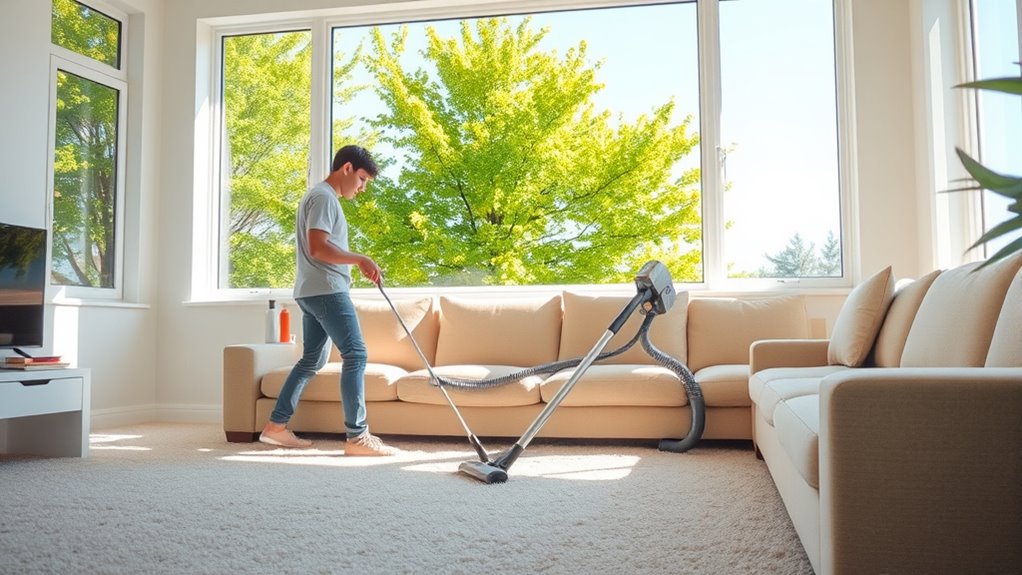
Outdoor particulates and allergens can quickly settle on your surfaces, making your vacuuming efforts less effective if not managed properly. To reduce their impact, control indoor humidity levels, ideally between 40-50%, which helps prevent allergens from becoming airborne. Use allergen barriers like sealed windows and door sweeps to minimize outdoor particles entering your home. Regularly cleaning outdoor entryways prevents dirt from tracking inside. Consider installing high-quality air purifiers with HEPA filters to capture airborne allergens. Keep windows closed during high pollen seasons, especially when wind speeds are high. Additionally, wipe down surfaces often to remove settled particles and maintain a cleaner environment that complements your vacuuming efforts. Maintaining proper indoor air quality is essential for a healthier home environment despite open windows. These steps help create a healthier indoor space despite open windows.
Targeted Cleaning of High-Traffic and Entry Areas
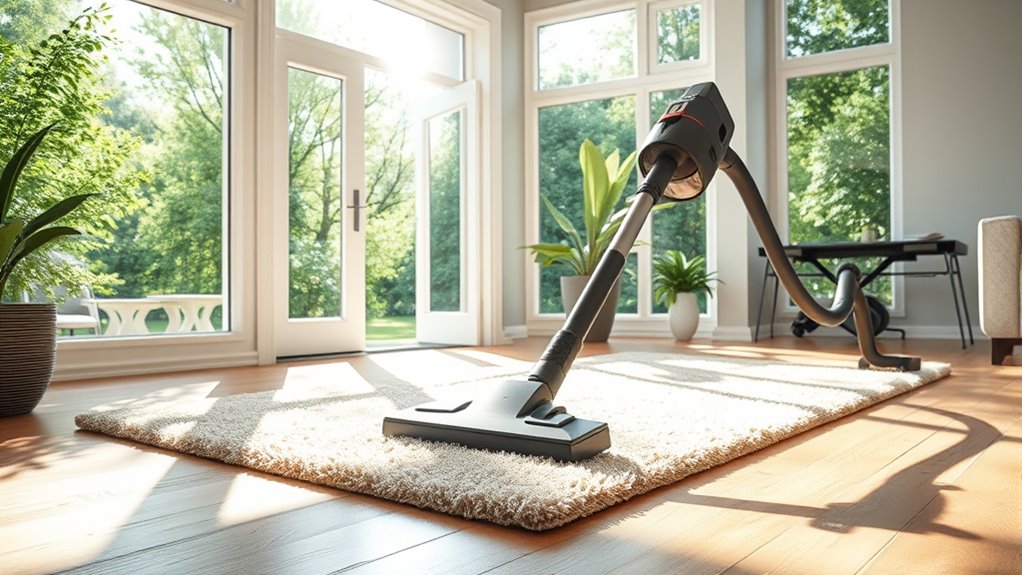
High-traffic and entry areas tend to accumulate dirt, debris, and wear quickly, making targeted cleaning essential to maintain a tidy home. Regularly vacuum these zones, focusing on corners and under furniture to remove tracked-in dirt. While vacuuming, pay attention to indoor plant care by gently cleaning around plant bases to prevent soil buildup. After vacuuming, refresh your entryway by polishing nearby furniture to reduce dust and add shine. Consistent attention to these areas prevents dirt from spreading throughout your home, especially with open windows. Keep entry mats clean and consider spot-cleaning high-touch surfaces to minimize germs. Incorporating appropriate vacuum attachments can enhance the effectiveness of cleaning these specific zones. This focused approach keeps your home fresh, reduces allergens, and prolongs the life of your furniture and indoor plants.
Incorporating Air Purifiers Alongside Vacuuming
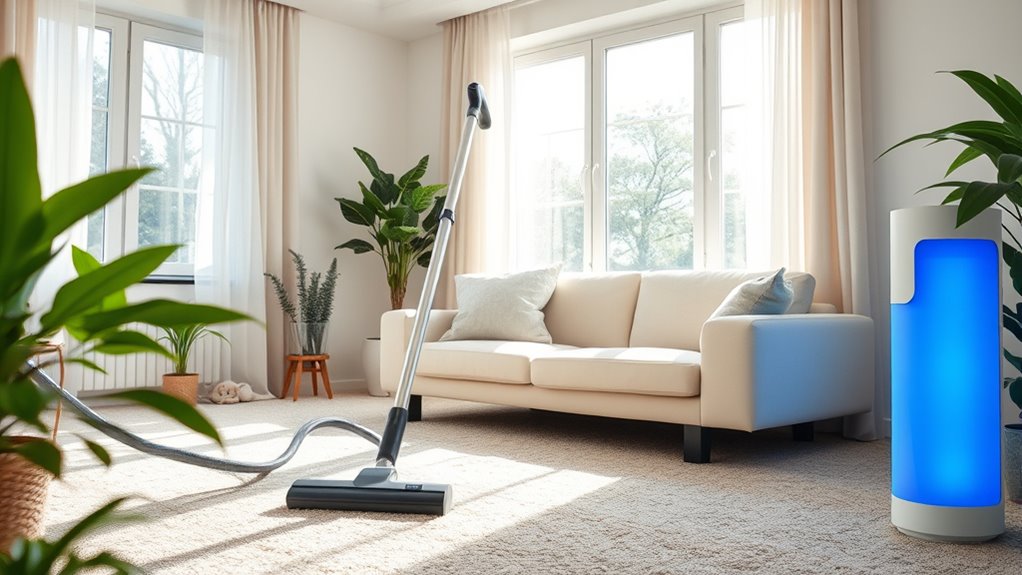
Incorporating air purifiers alongside vacuuming can markedly enhance your home’s indoor air quality. Proper air purifier placement guarantees maximum efficiency, such as positioning units away from walls and vents. You’ll also benefit from understanding indoor plant benefits—they naturally filter pollutants and add moisture to the air. To optimize your efforts, consider these tips:
Enhance air quality with strategic purifier placement and indoor plants for cleaner, healthier living spaces.
- Place air purifiers in high-traffic or open window areas
- Use multiple units for larger spaces
- Combine air purifiers with indoor plants for added purification
- Keep filters clean for consistent performance
- Regularly reposition air purifiers to cover different zones
- Select HEPA filter models that effectively capture airborne particles for better allergy relief.
Preventing Dust and Pollen From Settling in Hidden Areas
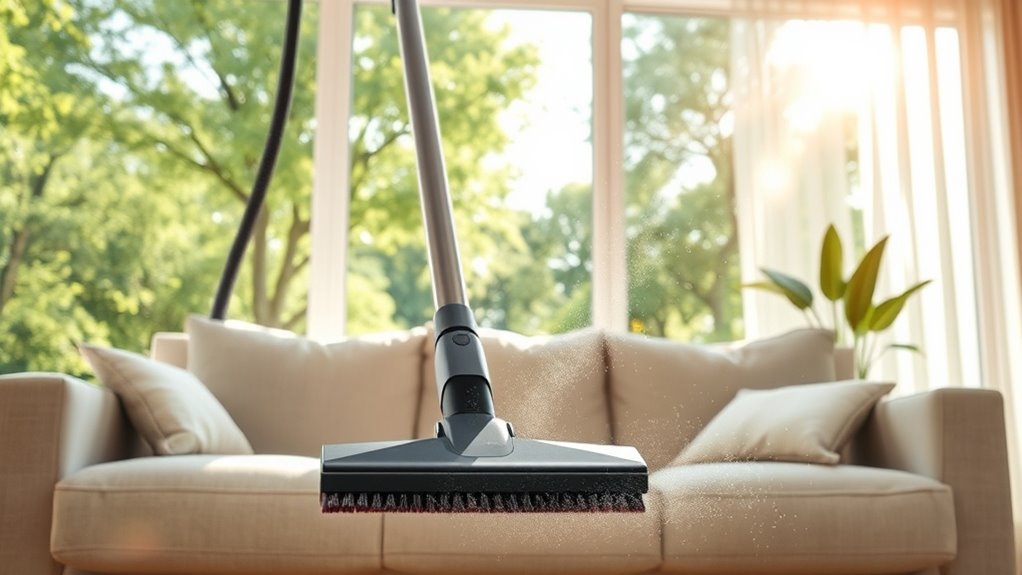
While air purifiers and indoor plants help improve air quality, dust and pollen can still settle unnoticed in hidden areas around your home. To prevent this, monitor and maintain ideal indoor humidity levels, ideally between 40-50%. Proper humidity reduces dust resettling and helps allergens stay airborne rather than settling into concealed spots. Regularly vacuum behind furniture, under appliances, and along baseboards, focusing on cracks and vents. Using a vacuum with a HEPA filter enhances allergen mitigation by trapping tiny particles. Additionally, consider dusting and wiping surfaces in hidden corners to remove settled allergens. Keeping humidity balanced and regularly cleaning these overlooked areas minimizes dust and pollen buildup, making it easier to maintain cleaner, healthier indoor spaces despite open windows. Suction power and filtration systems are essential for effective allergen removal during vacuuming.
Tips for Cleaning Window Screens and Surroundings
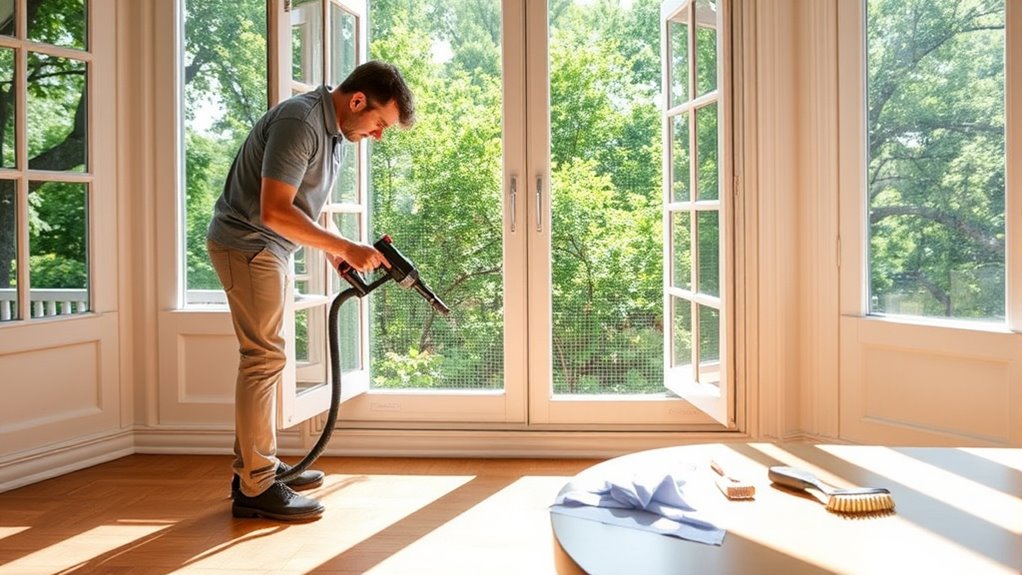
Start by removing loose debris from your window screens with a gentle shake or brush. Use the right vacuum attachments to avoid damaging the mesh, and don’t forget to clean the frame and tracks thoroughly. This will keep your windows looking fresh and functioning smoothly.
Remove Loose Debris
Removing loose debris from window screens and their surroundings is a crucial first step to guarantee a thorough cleaning. Clearing away dirt, leaves, and dust improves airflow optimization and reduces allergens, making your home healthier. To do this effectively, start by gently brushing the screens with a soft brush or vacuum attachment to loosen debris. Then, remove any larger debris by hand. Next, wipe the surrounding window frames and sills to prevent buildup. Keep these tips in mind:
- Use a vacuum with a brush attachment for delicate screens
- Gently brush away dirt before vacuuming
- Clear fallen leaves and dust from the window sill
- Wipe frames with a damp cloth
- Regularly inspect for accumulated debris to prevent allergy triggers
This process helps maintain better airflow and prevents allergy aggravation.
Use Appropriate Attachments
Have you chosen the right attachments to make your window screen cleaning more effective? Using the correct vacuum attachments can make a big difference. For cleaning screens, a dusting brush or a soft upholstery tool works best, gently removing dust and debris without damaging the mesh. For surrounding areas like window sills and ledges, switch to a crevice tool to reach tight spots and corners. Upholstery tools are also handy if your screens are attached to furniture or if you need to clean fabric curtains nearby. Avoid using a standard vacuum nozzle, which can be too harsh. By selecting the appropriate vacuum attachments, you’ll clean thoroughly and protect your screens and surroundings, making your year-round open window setup more comfortable and hygienic.
Clean Frame and Tracks
Wondering how to keep your window frames and tracks spotless? Regular frame cleaning and track maintenance are key to maintaining a clean look and preventing dust buildup. To do this effectively:
- Use a soft brush or vacuum attachment to remove loose debris from the frame and tracks
- Wipe down frames with a damp cloth and mild detergent
- Apply a sticky tape or vacuum to lift stubborn dust from tracks
- Use a small brush or toothbrush to clean tight corners
- Lubricate metal tracks with a silicone spray for smooth operation
Focusing on these steps ensures your window surroundings stay clean and functional. Proper track maintenance prevents jams, and regular frame cleaning keeps your windows looking sharp. Consistency makes window care quick and easy.
Maintenance and Upkeep of Your Vacuum Equipment
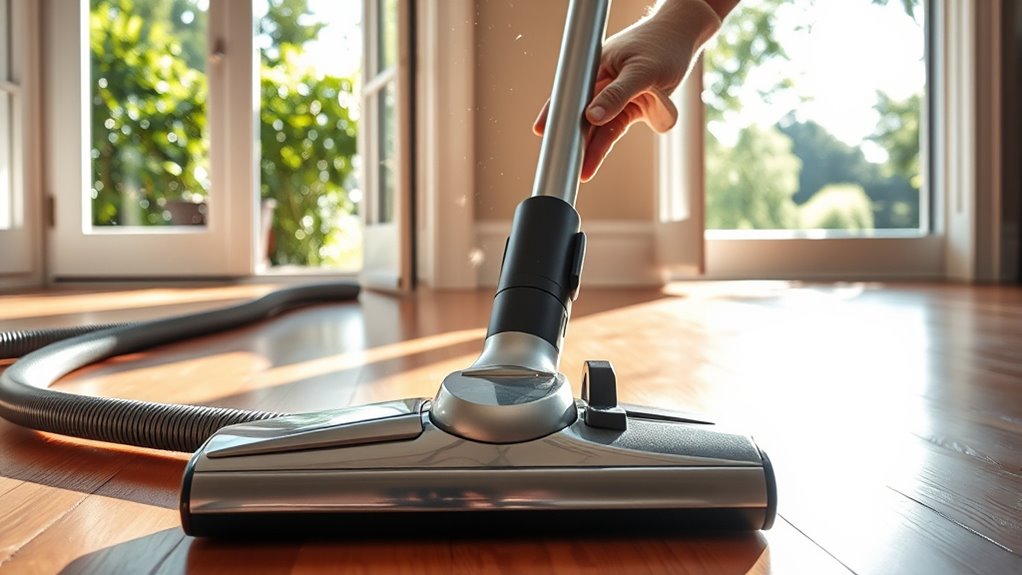
Regular maintenance is essential to keep your vacuum running efficiently and extend its lifespan. Start by regularly replacing the vacuum filter to guarantee optimal airflow and cleaning performance. A clean filter prevents dust buildup and keeps allergens at bay. If you have a cordless vacuum, proper cordless vacuum maintenance is vital; this includes checking the battery health, charging it correctly, and cleaning the brush rolls. Empty the dustbin or canister frequently to maintain suction power. Inspect the hose and attachments for blockages or debris. Keep the vacuum’s brushes and filters clean to prevent strain on the motor. Routine upkeep saves you time and money in the long run, assuring your vacuum is always ready for effective cleaning, even with open windows year-round.
Frequently Asked Questions
How Can I Minimize Outdoor Pollen Entering Through Open Windows?
To minimize outdoor pollen entering through open windows, consider using air purification devices with HEPA filters to trap allergens indoors. Additionally, you can improve window sealing by installing weatherstripping or screens that allow airflow while blocking pollen. Keep windows open during less windy times, such as after rain, and regularly clean filters and screens to reduce pollen buildup. These steps help maintain cleaner indoor air despite open windows.
Are There Specific Vacuum Features Best Suited for Open-Window Environments?
When choosing a vacuum for open-window environments, you want a model with a high-quality vacuum filter to trap pollen and outdoor debris effectively. Look for one with strong suction power, so it can pick up fine particles even with outdoor elements constantly entering your home. This guarantees you maintain a cleaner indoor space despite the ongoing influx of outdoor pollen, making your vacuuming more efficient and your home healthier.
How Does Weather Affect Vacuuming Strategies for Open-Window Homes?
Imagine your home’s airflow management as a delicate dance, where weather plays the lead. When it’s windy or rainy, you’ll want to adjust your vacuuming, sealing windows tightly when possible to prevent dust from blowing in. On breezy days, focus on cleaning more often to tackle increased dirt. Changing weather means adapting your strategies to keep your home clean, using window sealing and mindful scheduling to combat outdoor elements.
Can Vacuuming Alone Reduce Outdoor Allergens Effectively?
Vacuuming alone can help reduce indoor allergens, but its effectiveness depends on your vacuum filter maintenance. Regularly cleaning or replacing filters boosts air purifier effectiveness and captures more outdoor allergens. While vacuuming removes surface particles, using an air purifier with a HEPA filter complements this by trapping airborne allergens, making your efforts more effective. Combining these strategies guarantees a healthier indoor environment, especially with open windows year-round.
What Additional Steps Can I Take to Prevent Dust Buildup Near Open Windows?
Did you know that dust particles can increase by up to 60% near open windows? To prevent this buildup, you should regularly maintain your air purifier to guarantee ideal filtration. Also, consider sealing gaps around your windows with weatherstripping or caulking. These steps help reduce outdoor dust intrusion, making your home cleaner. Combining air purifier maintenance with window seal enhancements creates a more effective barrier against dust and allergens.
Conclusion
Just like a vigilant guardian guarding the gates of your home, your consistent vacuuming and maintenance keep outdoor elements at bay. Embrace these strategies to prevent dust, pollen, and debris from taking hold, ensuring your sanctuary stays fresh and healthy. Remember, with dedication and the right tools, you’re shaping a fortress of clean air—turning your open-window home into a haven, much like the timeless resilience of a well-guarded citadel.


